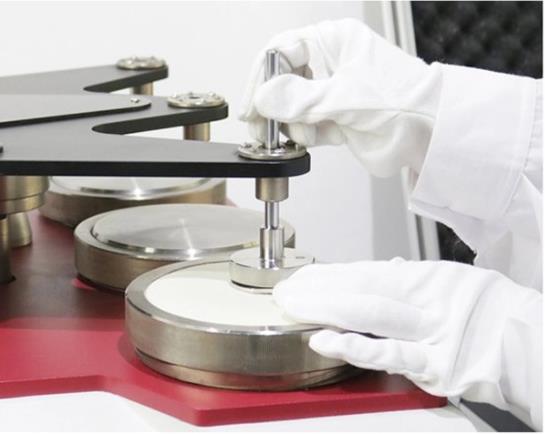The measurement of abrasion resistance, usually by the weighing of a material sample before and after subjecting it to a known abrasive stress throughout a known time period, or by reflectance or surface finish comparisons, or by dimensional comparisons.
The measurement of the resistance to abrasion of textile and other materials is very complex. The resistance to abrasion is affected by many factors, such as the inherent mechanical properties of the fibers; the dimensions of the fibers; the structure of the yarns; the construction of the fabrics; and the type, kind, and amount of finishing material added to the fibers, yarns, or fabric.
The resistance to abrasion is also greatly affected by the conditions of the tests, such as the nature of abradant, variable action of the abradant over the area of specimen abraded, the tension of the specimen, the pressure between the specimen and abradant, and the dimensional changes in the specimens.
Several factors are typically considered in developing or selecting an appropriate abrasion test for the application at hand.The shape of the contact area is taken into consideration, as is the composition of the two surfaces making contact with one another. Speed of sliding contact between the two surfaces, the force with which they act on one another,and the duration of contact between them may also be considered. In addition to the materials themselves, the environment in which they are making contact also plays a role in selecting an appropriate abrasion test.
Factors affecting abrasion resistance:
1)Fibre type:Nylon is generally considered to have the best abrasion resistance. Polyester and polypropylene also have good abrasion resistance. Blending either nylon or polyester with wool and cotton is found to increase their abrasion resistance. Viscose and acetates have the lowest abrasion resistance.
2)Fibre properties:A fabric made up with longer fibres gives better abrasion resistance than short fibres because they are harder to remove from the yarn. For the same reason filament yarns are more abrasion resistant than staple yarns made from the same fibre. Increasing fibre diameter up to a limit improves abrasion resistance.
3)Yarn twist:An optimum amount of twist in a yarn gives the best abrasion resistance. At low-twist factors, fibres can easily be removed from the yarn so that it is gradually reduced in diameter. At high twist levels, the fibres are held more tightly but the yarn is stiffer so it is hard abrade under pressure
4)Fabric structure:Fabrics with the crimp evenly distributed between warp and weft give the best wear because the damage is spread evenly between them.
